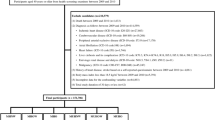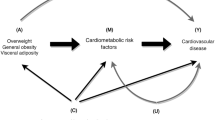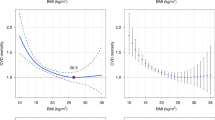Abstract
Background
The association between obesity and cardiovascular disease (CVD) in people without traditional CVD risk factors is unclear. This study aimed to investigate the association of obesity with CVD and its subtypes in people without traditional CVD risk factors.
Methods
Based on the Kailuan cohort study, the included participants were divided into different groups according to levels of body mass index (BMI) and waist height ratio (WHtR), respectively. Multivariate Cox proportional hazard models were used to evaluate the associations.
Results
This study included 31,955 participants [men 63.99%; mean age (48.14 ± 3.33) years]. During a median follow-up period of 12.97 (interquartile range: 12.68–13.17) years, 1298 cases of CVD were observed. Compared with the normal BMI group, the hazard ratios (HRs) for CVD, stroke, and myocardial infarction (MI) in the BMI obese group were 1.31 (95% confidence interval [CI] 1.11–1.55), 1.21 (95%CI 1.01–1.46), 1.62 (95%CI 1.13–2.33), respectively. Compared with the WHtR non-obese group, the HRs for CVD, stroke, and MI in the obese group were 1.25(95%CI 1.11–1.41), 1.18 (95%CI 1.03–1.34), 1.57 (95%CI 1.18–2.09), respectively. There was an interaction between age and WHtR (P for interaction was 0.043). The association between WHtR and CVD was stronger in people under 60 years old, with a HR of 1.44 (95%CI 1.24–1.67).
Conclusion
We found that obesity increased the risk of CVD in people without traditional CVD risk factors. The association of WHtR with CVD was stronger in people under 60 years old.
This is a preview of subscription content, access via your institution
Access options
Subscribe to this journal
Receive 12 print issues and online access
$259.00 per year
only $21.58 per issue
Buy this article
- Purchase on Springer Link
- Instant access to full article PDF
Prices may be subject to local taxes which are calculated during checkout


Similar content being viewed by others
Data availability
Some or all datasets generated during and/or analyzed during the current study are not publicly available but are available from the corresponding author on reasonable request.
References
World Health O. World health statistics 2021: monitoring health for the SDGs, sustainable development goals, World Health Organization: Geneva, 2021
Fernandez-Friera L, Fuster V, Lopez-Melgar B, Oliva B, Garcia-Ruiz JM, Mendiguren J, et al. Normal LDL-Cholesterol Levels Are Associated With Subclinical Atherosclerosis in the Absence of Risk Factors. J Am Coll Cardiol. 2017;70:2979–91.
Silverman MG, Blaha MJ, Krumholz HM, Budoff MJ, Blankstein R, Sibley CT, et al. Impact of coronary artery calcium on coronary heart disease events in individuals at the extremes of traditional risk factor burden: the Multi-Ethnic Study of Atherosclerosis. Eur Heart J. 2014;35:2232–41.
Whelton SP, McEvoy JW, Shaw L, Psaty BM, Lima JAC, Budoff M, et al. Association of Normal Systolic Blood Pressure Level With Cardiovascular Disease in the Absence of Risk Factors. Jama Cardiol. 2020;5:1011–8.
Won KB, Park GM, Yang YJ, Ann SH, Kim YG, Yang DH, et al. Independent role of low-density lipoprotein cholesterol in subclinical coronary atherosclerosis in the absence of traditional cardiovascular risk factors. Eur Heart J Cardiovasc Imaging. 2019;20:866–72.
Zuo Y, Han X, Tian X, Chen S, Wu S, Wang A. Association of Impaired Fasting Glucose With Cardiovascular Disease in the Absence of Risk Factor. J Clin Endocrinol Metab. 2022;107:e1710–e1718.
Zheng R, Xu Y, Li M, Lu J, Wu S, Niu J et al. Examining the Linear Association Between Blood Pressure Levels and Cardiovascular Diseases in the Absence of Major Risk Factors in China. Circ Cardiovasc Qual Outcomes. 2022: 101161CIRCOUTCOMES121008774
Thomas R, Ambookan PV, Jose J, Unnikrishnan UG. The accuracy of anthropometric measurements of general and central obesity for the prediction of impaired glucose tolerance among the adult population of South India. J Family Med Prim Care. 2020;9:3416–20.
Hansen L, Netterstrom MK, Johansen NB, Ronn PF, Vistisen D, Husemoen LLN, et al. Metabolically Healthy Obesity and Ischemic Heart Disease: A 10-Year Follow-Up of the Inter99 Study. J Clin Endocrinol Metab. 2017;102:1934–42.
Matsunaga M, Yatsuya H, Iso H, Li Y, Yamagishi K, Tanabe N, et al. Impact of Body Mass Index on Obesity-Related Cancer and Cardiovascular Disease Mortality; The Japan Collaborative Cohort Study. J Atheroscler Thromb. 2022;29:1547–62.
Pasdar Y, Moradi S, Moludi J, Saiedi S, Moradinazar M, Hamzeh B, et al. Waist-to-height ratio is a better discriminator of cardiovascular disease than other anthropometric indicators in Kurdish adults. Sci Rep-UK. 2020;10:16228.
Song X, Jousilahti P, Stehouwer CDA, Soderberg S, Onat A, Laatikainen T, et al. Comparison of various surrogate obesity indicators as predictors of cardiovascular mortality in four European populations. Eur J Clin Nutr. 2013;67:1298–302.
Tabary M, Cheraghian B, Mohammadi Z, Rahimi Z, Naderian MR, Danehchin L, et al. Association of anthropometric indices with cardiovascular disease risk factors among adults: a study in Iran. Eur J Cardiovasc Nur. 2021;20:358–66.
Wohlfahrt P, Somers VK, Cifkova R, Filipovsky J, Seidlerova J, Krajcoviechova A, et al. Relationship between measures of central and general adiposity with aortic stiffness in the general population. Atherosclerosis. 2014;235:625–31.
Caleyachetty R, Thomas GN, Toulis KA, Mohammed N, Gokhale KM, Balachandran K, et al. Metabolically Healthy Obese and Incident Cardiovascular Disease Events Among 3.5 Million Men and Women. J Am Coll Cardiol. 2017;70:1429–37.
Opio J, Croker E, Odongo GS, Attia J, Wynne K, McEvoy M. Metabolically healthy overweight/obesity are associated with increased risk of cardiovascular disease in adults, even in the absence of metabolic risk factors: A systematic review and meta-analysis of prospective cohort studies. Obes Rev. 2020;21:e13127.
Käräjämäki AJ, Korkiakoski A, Hukkanen J, Kesäniemi YA, Ukkola O. Long-term metabolic fate and mortality in obesity without metabolic syndrome. Ann Med. 2022;54:1432–43.
Eckel N, Meidtner K, Kalle-Uhlmann T, Stefan N, Schulze MB. Metabolically healthy obesity and cardiovascular events: A systematic review and meta-analysis. Eur J Prev Cardiol. 2016;23:956–66.
Zheng R, Zhou D, Zhu Y. The long-term prognosis of cardiovascular disease and all-cause mortality for metabolically healthy obesity: a systematic review and meta-analysis. J Epidemiol Community Health. 2016;70:1024–31.
Radholm K, Chalmers J, Ohkuma T, Peters S, Poulter N, Hamet P, et al. Use of the waist-to-height ratio to predict cardiovascular risk in patients with diabetes: Results from the ADVANCE-ON study. Diabetes Obes Metab. 2018;20:1903–10.
Khalili S, Hatami M, Hadaegh F, Sheikholeslami F, Azizi F. Prediction of Cardiovascular Events with Consideration of General and Central Obesity Measures in Diabetic Adults: Results of the 8.4-Year Follow-Up. Metab Syndr Relat D. 2012;10:218–24.
Wang C, Yuan Y, Zheng M, Pan A, Wang M, Zhao M, et al. Association of Age of Onset of Hypertension With Cardiovascular Diseases and Mortality. J Am Coll Cardiol. 2020;75:2921–30.
Wang X, Feng B, Huang Z, Cai Z, Yu X, Chen Z, et al. Relationship of cumulative exposure to the triglyceride-glucose index with ischemic stroke: a 9-year prospective study in the Kailuan cohort. Cardiovasc Diabetol. 2022;21:66.
Tian X, Wang P, Chen S, Zhang Y, Zhang X, Xu Q, et al. Association of serum uric acid to lymphocyte ratio, a novel inflammatory biomarker, with risk of stroke: A prospective cohort study. CNS Neurosci Ther. 2023;29:1168–77.
Arnett DK, Blumenthal RS, Albert MA, Buroker AB, Goldberger ZD, Hahn EJ, et al. 2019 ACC/AHA Guideline on the Primary Prevention of Cardiovascular Disease: Executive Summary: A Report of the American College of Cardiology/American Heart Association Task Force on Clinical Practice Guidelines. J Am Coll Cardiol. 2019;74:1376–414.
Grundy SM, Stone NJ, Bailey AL, Beam C, Birtcher KK, Blumenthal RS, et al. 2018 AHA/ACC/AACVPR/AAPA/ABC/ACPM/ADA/AGS/APhA/ASPC/NLA/PCNA Guideline on the Management of Blood Cholesterol: Executive Summary: A Report of the American College of Cardiology/American Heart Association Task Force on Clinical Practice Guidelines. J Am Coll Cardiol. 2019;73:3168–209.
Goff DC Jr, Lloyd-Jones DM, Bennett G, Coady S, D’Agostino RB, Gibbons R, et al. 2013 ACC/AHA guideline on the assessment of cardiovascular risk: a report of the American College of Cardiology/American Heart Association Task Force on Practice Guidelines. Circulation. 2014;129:S49–73.
Stroke--1989. Recommendations on stroke prevention, diagnosis, and therapy. Report of the WHO Task Force on Stroke and other Cerebrovascular Disorders. Stroke. 1989;20:1407–31.
Tunstall-Pedoe H, Kuulasmaa K, Amouyel P, Arveiler D, Rajakangas AM, Pajak A. Myocardial infarction and coronary deaths in the World Health Organization MONICA Project. Registration procedures, event rates, and case-fatality rates in 38 populations from 21 countries in four continents. Circulation. 1994;90:583–612.
Zhao Y, Qie R, Han M, Huang S, Wu X, Zhang Y, et al. Association of BMI with cardiovascular disease incidence and mortality in patients with type 2 diabetes mellitus: A systematic review and dose-response meta-analysis of cohort studies. Nutr Metab Cardiovasc Dis. 2021;31:1976–84.
Iliodromiti S, Celis-Morales CA, Lyall DM, Anderson J, Gray SR, Mackay DF, et al. The impact of confounding on the associations of different adiposity measures with the incidence of cardiovascular disease: a cohort study of 296 535 adults of white European descent. Eur Heart J. 2018;39:1514–20.
Bae JC, Cho NH, Kim JH, Hur KY, Jin SM, Lee MK. Association of Body Mass Index with the Risk of Incident Type 2 Diabetes, Cardiovascular Disease, and All-Cause Mortality: A Community-Based Prospective Study. Endocrinol Metab (Seoul). 2020;35:416–24.
Eckel N, Li Y, Kuxhaus O, Stefan N, Hu FB, Schulze MB. Transition from metabolic healthy to unhealthy phenotypes and association with cardiovascular disease risk across BMI categories in 90 257 women (the Nurses’ Health Study): 30 year follow-up from a prospective cohort study. Lancet Diabetes Endocrinol. 2018;6:714–24.
Xue R, Li Q, Geng Y, Wang H, Wang F, Zhang S. Abdominal obesity and risk of CVD: a dose-response meta-analysis of thirty-one prospective studies. Br J Nutr. 2021;126:1420–30.
Kruszewska J, Cudnoch-Jedrzejewska A, Czarzasta K. Remodeling and Fibrosis of the Cardiac Muscle in the Course of Obesity-Pathogenesis and Involvement of the Extracellular Matrix. Int J Mol Sci. 2022;23:4195.
Gutierrez-Cuevas J, Sandoval-Rodriguez A, Meza-Rios A, Monroy-Ramirez HC, Galicia-Moreno M, Garcia-Banuelos J, et al. Molecular Mechanisms of Obesity-Linked Cardiac Dysfunction: An Up-Date on Current Knowledge. Cells. 2021;10:629.
Rothman KJ, Poole C. A strengthening programme for weak associations. Int J Epidemiol. 1988;17:955–9.
Acknowledgements
We thank all study participants, their relatives, the members of the survey teams at the 11 regional hospitals of the Kailuan Medical Group; and the project development and management teams at the Beijing Tiantan Hospital and the Kailuan Group. This work was supported by National Key Research and Development Program of China (2022YFC3600600), Fund for Young Talents of Beijing Medical Management Center (QML20230505), National Natural Science Foundation of China (81773512), and Beijing Municipal Administration of Hospitals Incubating Program (PX2020021).
Author information
Authors and Affiliations
Contributions
HL, and YesongLiu drafted the manuscript and conducted the statistical analysis. XT revised the manuscript for intellectual content and interpreted the data. YZ, LL, ZZ, and LL interpreted the data. YZ and XJ collected the epidemiological and clinical data. YLiu, YLuo, and AW designed the study, had full access to all the data and take responsibility for the integrity of the data and the accuracy of the data analysis. All authors approved the final version.
Corresponding authors
Ethics declarations
Competing interests
The authors declare no competing interests.
Additional information
Publisher’s note Springer Nature remains neutral with regard to jurisdictional claims in published maps and institutional affiliations.
Supplementary information
Rights and permissions
Springer Nature or its licensor (e.g. a society or other partner) holds exclusive rights to this article under a publishing agreement with the author(s) or other rightsholder(s); author self-archiving of the accepted manuscript version of this article is solely governed by the terms of such publishing agreement and applicable law.
About this article
Cite this article
Luo, H., Liu, Y., Tian, X. et al. Association of obesity with cardiovascular disease in the absence of traditional risk factors. Int J Obes 48, 263–270 (2024). https://doi.org/10.1038/s41366-023-01408-z
Received:
Revised:
Accepted:
Published:
Issue Date:
DOI: https://doi.org/10.1038/s41366-023-01408-z



